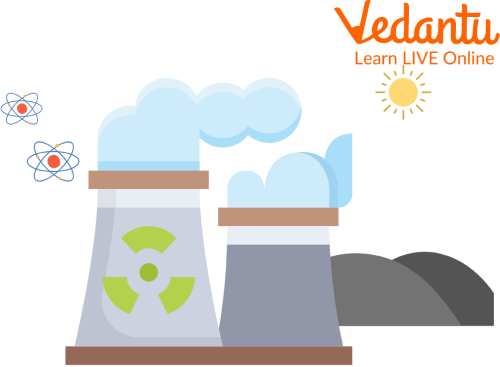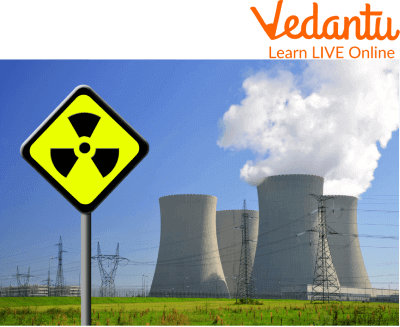




What Is Nuclear Energy? Key Terms Explained for Students
For many years, the increase in electricity consumption has exceeded the increase in final energy demand. Rising power demand is primarily a result of the increased digitisation of end users, including transportation, space cooling, major appliances, ICT, and others. There are now far fewer individuals without access to power than one billion.
About 10% of the world's power is generated by nuclear power, a recognised component of the global electrical mix. It is especially suitable for supplying continuous, large-scale energy demand where dependability and predictability are crucial, making it the perfect complement for the global urbanisation trend. Let’s find out more exciting things about it!
What is Nuclear Energy?
Nuclear or atomic energy is the force that maintains the integrity of an atom's nucleus. The fundamental building components of matter are atoms. The core of an atom is its nucleus. Nuclear energy transforms into different forms of energy as it is released. These energy types are referred to as radiation. Radiation can take the form of heat or light.
Nuclear fusion and nuclear fission are two methods for releasing nuclear energy. Nuclear fission occurs when an atom's nucleus breaks into several pieces. When two nuclei combine to form a true nucleus, nuclear fusion takes place. Some atoms' nuclei have the ability to release nuclear energy without fissioning or fusing. We refer to these atoms as radioactive.

Nuclear Energy
Stars, like the Sun, naturally undergo nuclear fusion. Nuclear energy is constantly being produced by the atoms there. The energy and light the Sun emit toward Earth come from that energy.
Scientists found that they could induce nuclear fission in specific types of atoms in the 1930s. They made their finding while experimenting with uranium atoms. By blasting uranium atoms with neutrons, they could divide the nucleus in half. A lot of energy is released during nuclear fission. For instance, burning 3,000 tonnes of coal would require as much energy as fissioning 1 pound (0.5 kilograms) of uranium.
Example of Nuclear Energy
Given below are some examples of nuclear energy:
1. Treatments in Food
Nuclear energy and technologies are employed in the food and agricultural industries to improve safety and efficiency. To limit the need for insecticides, agricultural pests are sterilised using nuclear-related technology.
2. Nuclear Medicine
Some byproducts produced by nuclear fission in reactors are crucial for some medical fields. For instance, hospitals employ cobalt-60 to clean complex medical equipment, such as implants, catheters, and scalpels, as well as other types of technology.
3. Exploration of Space
Deep space exploration can be powered by nuclear energy through generators. Before being destroyed in 2017, the Cassini-Huygens probe used a Radioactive Isotope Thermoelectric Generator (RTG) to study Saturn.
4. Electricity
When considering nuclear energy, you probably picture how nuclear fission fuel is employed to produce electricity. This is accomplished in a nuclear power plant during the reactor's splitting of uranium.
5. Nuclear Weapons
Weapons like the atom or hydrogen bomb also come to mind when thinking about nuclear energy. These bombs produce a potent explosion that can quickly level enormous areas using nuclear fusion and fission.
Who Discovered Nuclear Energy?
In the 1930s, scientist Enrico Fermi first demonstrated how neutrons could divide atoms, which gave rise to the concept of nuclear power. At the University of Chicago, Fermi oversaw a team that, in 1942, created the first nuclear chain reaction beneath a stadium.
The Obninsk Nuclear Power Plant in the USSR produced about 5 megawatts of electricity on June 27, 1954, making it the first nuclear power plant in the world to provide electricity for a power grid.

Generation of Nuclear Energy
Summary
Nuclear energy is a type of energy that comes from the nucleus, or core, of an atom. It was first discovered in the early 1900s by scientists studying radioactivity. Today, nuclear energy is used to generate electricity, treat cancer and other medical conditions, and research purposes. It also has applications in the military, such as in nuclear weapons. We read about nuclear energy for kids in this article, and we also looked at some nuclear energy images.
FAQs on Nuclear Energy for Kids: Definitions, Examples & Practice
1. What is nuclear energy, explained in simple words?
Imagine an atom is a tiny, tiny ball. In the very centre of this ball is a core called the nucleus. Nuclear energy is the powerful energy that is locked up inside this nucleus. When we split this nucleus or join two nuclei together, this energy is released as heat and light.
2. What are some examples of how nuclear energy is used in the real world?
Nuclear energy is used in several important ways that help us every day. These include:
- Making Electricity: Huge power plants use nuclear energy to create a lot of electricity for our homes, schools, and cities without producing smoke.
- Helping Doctors: In hospitals, special tools powered by nuclear technology are used to sterilise medical equipment and even help treat some diseases.
- Exploring Space: Spacecraft that travel very far, like to other planets, sometimes use nuclear energy as a long-lasting power source.
- Keeping Food Safe: It can be used to get rid of harmful germs in food, making it safer for us to eat.
3. Does making nuclear energy cause air pollution?
No, nuclear power plants do not create air pollution. Unlike burning coal or gas, the process of creating nuclear energy, called nuclear fission, does not release harmful gases like carbon dioxide into the air. This makes it a clean source of electricity that helps protect our air quality.
4. What are the main advantages of using nuclear energy?
The main advantages of nuclear energy are:
- It's very powerful: A very small amount of nuclear fuel can produce a huge amount of electricity, as much as thousands of tonnes of coal.
- It's clean: It doesn't pollute the air, which helps keep our planet healthy.
- It's reliable: Nuclear power plants can run 24 hours a day, 7 days a week, providing a steady and dependable supply of power.
5. How do scientists get energy out of a tiny atom?
Scientists use a process called nuclear fission. They take a specific type of atom, like uranium, and shoot a tiny particle at its nucleus. This causes the nucleus to split into smaller pieces, which releases a tremendous amount of energy in the form of heat. This heat is then used to boil water, create steam, and turn turbines to generate electricity.
6. Is nuclear energy a renewable source like solar or wind power?
No, nuclear energy is not considered renewable. Renewable energy sources like the sun and wind will never run out. Nuclear energy comes from a material called uranium, which is a mineral mined from the Earth. Since there is a limited amount of uranium available, it could eventually run out, so it is classified as a non-renewable resource.
7. Why is the sun often called a giant nuclear energy machine?
The sun produces energy through a different process called nuclear fusion. Instead of splitting atoms apart, the immense heat and pressure at the sun's core forces tiny atoms to smash together and fuse into a new, bigger atom. This fusion process releases even more energy than fission, which is why the sun gives off so much light and heat to our planet.
8. How is nuclear energy kept safe in power plants?
Nuclear power plants are built with many layers of safety systems to prevent accidents. They have very thick concrete and steel walls to contain the energy and have strict rules and automated controls to manage the process safely. While the process is powerful, these special designs ensure it is controlled and used to generate electricity safely. The waste it produces, however, must be stored very carefully for a long time.









